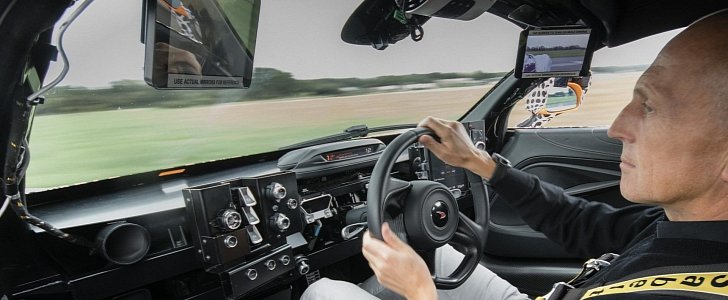Late last year, McLaren Automotive came clean about its next Ultimate Series model. Codenamed BP23, the mysterious model is confirmed to sport a three-seat layout like the record-breaking McLaren F1 from the 1990s and a lot more comfort than the P1, thus earning the “hyper-GT” description from its creator.
After a series of design sketches, the BP23 returns as a development mule. Borrowing the body shell from the 720S, the prototype reveals the central driving position we’ve been anxiously waiting from McLaren. The only photograph of the interior shows bits and bobs borrowed from the 720S, as well as plenty of makeshift buttons, switches, and exposed wiring. Make no mistake about it, but the BP23 is a work-in-progress at this moment.
Focusing on the camouflage masking the bodywork, you’ll notice the trademark Papaya Orange paint found on old-school McLaren racing cars and road-going models. A quick search with the DVLA reveals that the mule was registered in the United Kingdom in November 2016 as an orange-painted car.
Similarly to the F1, the BP23 features two passenger seats located a little further back compared to the driver’s seat. From this point of view, it’s easy to see that the prototype features two TFT screens that display video feed from two cameras mounted in the A-pillars. That’s curious, to say the least, more so when you notice that mirrors are also present and do the job fine.
The McLaren BP23 will start shipping to customers in 2019, with only 106 examples confirmed for production. All of them are sold out, with pricing reportedly starting at $2.5 million. The powertrain is hybrid, combining electric motor(s) with a twin-turbo V8, potentially borrowed from the 720S.
Instead of an ending note, here are three things McLaren promises the BP23 will be. In the first instance, look forward to the “the most powerful and most aerodynamic road-going McLaren ever.” Combine powerful with aerodynamic, and you’ll also get probably the fastest McLaren of the modern era.
Coincidence or not, the automaker published these photos of the BP23 on the 5th anniversary since the P1 was previewed as a design study in 2012.
Focusing on the camouflage masking the bodywork, you’ll notice the trademark Papaya Orange paint found on old-school McLaren racing cars and road-going models. A quick search with the DVLA reveals that the mule was registered in the United Kingdom in November 2016 as an orange-painted car.
Similarly to the F1, the BP23 features two passenger seats located a little further back compared to the driver’s seat. From this point of view, it’s easy to see that the prototype features two TFT screens that display video feed from two cameras mounted in the A-pillars. That’s curious, to say the least, more so when you notice that mirrors are also present and do the job fine.
The McLaren BP23 will start shipping to customers in 2019, with only 106 examples confirmed for production. All of them are sold out, with pricing reportedly starting at $2.5 million. The powertrain is hybrid, combining electric motor(s) with a twin-turbo V8, potentially borrowed from the 720S.
Instead of an ending note, here are three things McLaren promises the BP23 will be. In the first instance, look forward to the “the most powerful and most aerodynamic road-going McLaren ever.” Combine powerful with aerodynamic, and you’ll also get probably the fastest McLaren of the modern era.
Coincidence or not, the automaker published these photos of the BP23 on the 5th anniversary since the P1 was previewed as a design study in 2012.





